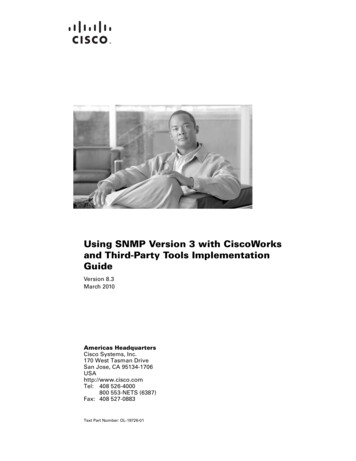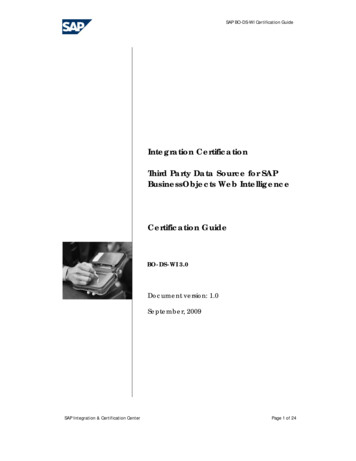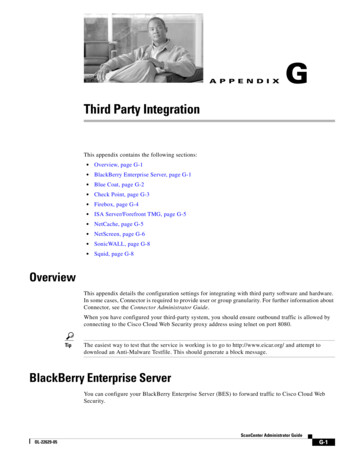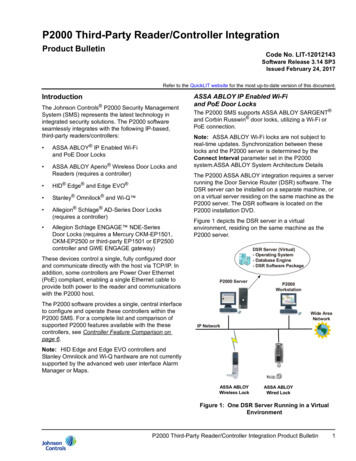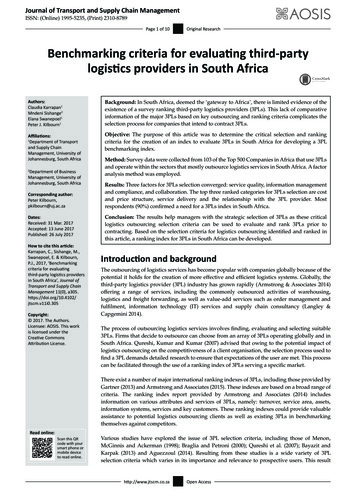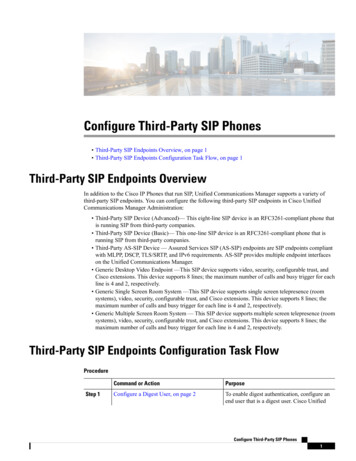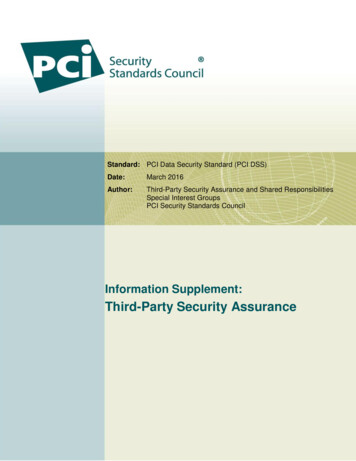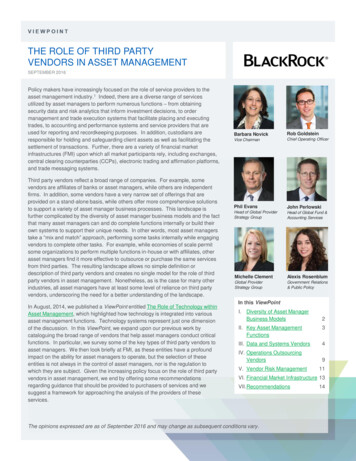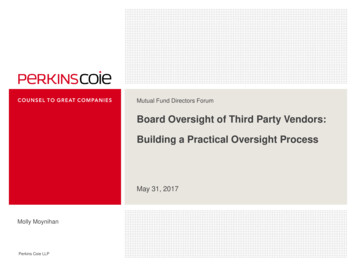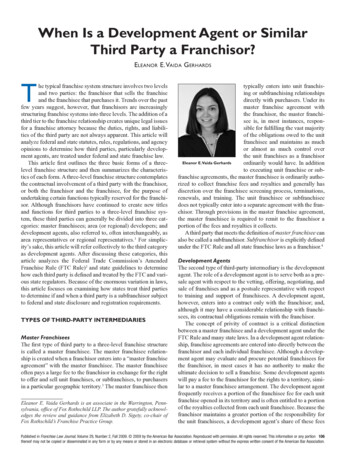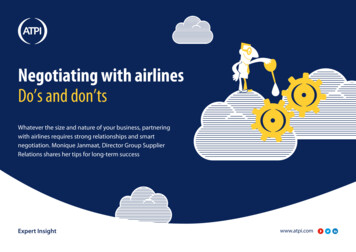
Transcription
Presenting a live 90-minute webinar with interactive Q&ANegotiating and Drafting Third-PartyLogistics Provider AgreementsStructuring Terms and Conditions; Anticipating Common Areas of Dispute;Navigating State, Federal and International Laws and TreatiesWEDNESDAY, JUNE 8, 20161pm Eastern 12pm Central 11am Mountain 10am PacificToday’s faculty features:Eric Baker, Partner, SmithAmundsen, IndianapolisKaryn A. Booth, Partner & Chair of Transportation Practice, Thompson Hine, Washington, D.C.Lew R.C. Bricker, Partner, SmithAmundsen, ChicagoPaul W. Stewart, BBA, MA, JD, Logistics Law, Germantown, Tenn.The audio portion of the conference may be accessed via the telephone or by using your computer'sspeakers. Please refer to the instructions emailed to registrants for additional information. If youhave any questions, please contact Customer Service at 1-800-926-7926 ext. 10.
Tips for Optimal QualityFOR LIVE EVENT ONLYSound QualityIf you are listening via your computer speakers, please note that the qualityof your sound will vary depending on the speed and quality of your internetconnection.If the sound quality is not satisfactory, you may listen via the phone: dial1-866-570-7602 and enter your PIN when prompted. Otherwise, pleasesend us a chat or e-mail sound@straffordpub.com immediately so we canaddress the problem.If you dialed in and have any difficulties during the call, press *0 for assistance.Viewing QualityTo maximize your screen, press the F11 key on your keyboard. To exit full screen,press the F11 key again.
Continuing Education CreditsFOR LIVE EVENT ONLYIn order for us to process your continuing education credit, you must confirm yourparticipation in this webinar by completing and submitting the AttendanceAffirmation/Evaluation after the webinar.A link to the Attendance Affirmation/Evaluation will be in the thank you emailthat you will receive immediately following the program.For additional information about continuing education, call us at 1-800-926-7926ext. 35.
Program MaterialsFOR LIVE EVENT ONLYIf you have not printed the conference materials for this program, pleasecomplete the following steps: Click on the symbol next to “Conference Materials” in the middle of the lefthand column on your screen. Click on the tab labeled “Handouts” that appears, and there you will see aPDF of the slides for today's program. Double click on the PDF and a separate page will open. Print the slides by clicking on the printer icon.
Best Considerations WhenNegotiating and Drafting Third-PartyLogistics Provider AgreementsLew BrickerSmithAmundsen LLCChicago, ILJune 8, 2016
Overview Negotiating and Drafting Third-PartyLogistics Provider Agreements Historical approaches and the new type ofagreementSelecting 3PL providersNegotiating contracts with 3PL providersMeasuring performanceTerminating 3PL provider relationshipsGoal6
Negotiating and DraftingThird-PartyLogistics Provider Agreements(Or Not Your Uncle’s Cut and Paste)Strafford CLE WebinarPresentation by Paul W. StewartJune 8, 2016
Career Perspective Trial LawyerGC to major international logistics co (17yrs)Business side experience as EVP strategic dev.Led acquisitions of 3PLs over 450MConsulting for venture capital projects in 3PLCEO of 3PL start-up to sale in 3 YrsPrivate practice exclusively representing supply chainmanagement (SCM) clients8
Understanding the 3PL Relationship Getting to fair and effective 3PL Agreement canbe complicated. Traditional 2-party SCM functions (i.e.,shipper/carrier; bailor/warehouseman, etc.), arelinear and roles are more easily defined Adding “third party” creates multi-dimensional,multi-party relationship (more than 3) Additional participants are incalculable legalimplications must be anticipated9
Defining Third Party Logistics Provider(3PL) There is no “standard” or acceptable “legal”definition will vary from contract to contract Provider’s point of view from simple logisticalactivities to advanced logistical solutions Client’s point of view degree of outsourcing variesand outsourced logistics activities differ greatly,sometimes without clarity in your client’s strategicplan (first challenge in drafting proper agreement)SUGGESTED RULE: Counsel must fully understand actual services sought byclient in relation to likely capabilities, authorizations and expectations of3PL there is almost always latent dissonance(continued)10
Defining Third Party Logistics Provider(3PL) continued 1. Interview client extensively as to nature of servicesexpected2. Review client’s selection criteria3. Compare client’s RFP (if used) with 3PL’s responseto RFP and RFI4. Never assume client is not trying to put a round peginto a square hole it has consequencesSee: rokerage-Activity.pdf11
Distinguishing Transaction Based andOutcome Based 3PL Agreements The nature and extent of the MSA, along withsupporting schedules, is determined by thesedistinctions:Transaction Based*Transactional Cost ReductionOperations Controlled by SLA’sSeldom have client and 3PL aligned objectivesSOW’s define precisely what/how tasks are doneCompensation by pricing schedule w/ gain sharingOutcome BasedPursuing Desired OutcomesMutually motivated by added valueDiligence has aligned objectivesSOO’s defines goals, but not howCompensation by min margin and new value12
Selected Elements of TransactionBased MSA1.2.Structure – provide services as specified in schedules, standard of care; function ofSOW’s as attached to schedules; incorporation of docsTerm and Termination – initial term; renewal options; for cause termination perhapsmost important is an exit plan (See: .4.Fees, Charges and Expenses – by schedule; surcharges; changes in operatingparameters or conditions allowing proposed adjustmentsIndemnification - mutual for negligence of employees or agents (not subcontractors)other than indemnitee, and excepting Goods under management (for cargo loss anddamage claims) Broad indemnity provisions vs. real responsibility of CounselFull review of exposure should emphasize insurance over indemnity for remote parties and potentialvicarious liabilityCatch 22 in nullifying insurance due to “liability assumed by contract” insurance exclusionsOnly “contractual liability coverage” policy will insure indemnitor for “extraneous” liabilityPerformance penalties to which your client is bound by their customers must be coveredDo not tie the swing to the tree by making terms non-negotiable(continued)13
Selected Elements of TransactionBased MSA continued6.7.Solicitation or Hiring Employees – especially needed due to “keys to thekingdom” of both parties’ SCM talent; should be mutual during and forreasonable time after term of Agreement, may have reasonableexceptionsWarranty of Payment to Subcontractors and Release of Liens – 3PL solelyand exclusively liable to subcontractors for payment of charges tocarriers and warehousemen; include in all contracts with subcontractorsthey agree to look only to 3PL for payment of all transportation relatedcharges; agree to defend and indemnify client for all subsequent claimsfor non-payment. (as additional protections of the “double payment”exposure parties should agree in “Bill of Lading” requirements thatshipper will execute non-recourse Section 7 of bill of lading and specifyas “Prepaid”)(See: abilities-exposed-who-gets-stuck-with-the-bill/ ld.pdf14
Characteristics of Outcome BasedAgreement Fully collaborativeAssumes a partnership toward mutual new valueMust be flexible with fundamental protectionsMSA covers fundamental definitions, mutualintentions, reps and warranties, and incorporatesall Schedules wherein objectives, desiredoutcomes, performance measurement, pricing,relationship management and termination/exitplan are specified15
The Contracting ContinuumTraditional/RigidYou should writeevery trivialaspect of thebusinessagreement instone.FlexibleFrameworkRelational /“Handshake”A contract is aflexibleframeworkdesigned tocreate“instruments forsocialcooperation”If you have agood businessrelationship, youdo not need awritten contract.16
Traditional Contracting Theory Contracts are typically rooted in the “classicalapproach” to contract law The classical approach is crafted to address:– How to manage transactions, such as documenting astatement of work and the associated pricing andservice levels; and,– Legal protections, such as limitation of liability,indemnification and liquidated damages17
Collaborative Logistics Requires a Shiftin Contracting Perspective Relationship must shift from protecting informationto full sharing Mutual trust must be exemplified among principals Counsel must approach contracting withunderstanding of risk and reward sharing MCA and schedules must reflect flexibility18
What Is Vested? Vested is a business model, methodology, mindset andmovement for creating highly collaborative businessrelationships that enable true win-win relationships in whichboth parties are equally committed to each other’s success. When applied, a Vested approach fosters an environment thatsparks innovation, resulting in improved service, reducedcosts and value that didn’t exist before — for both parties. Vested is based on award-winning research conducted by theUniversity of Tennessee College of Business Administrationand funded by the U.S. Air Force19
Address The MSA Early Many organizations find getting the legal terms righttakes time and discussion. The Vested methodology calls for parties to addressthe MSA and overall contract structure at thebeginning of process Discussing potential disconnects on legal issues orconcerns upfront allow the the parties to understandif they have common ground before spending timeand energy to on the details of the businessagreement – what goes into the schedules20
Vested Agreement StructureMASTERSERVICESAGREEMENT(MSA)RULE 1Element 1BUSINESS MODELSTATEMENT OFINTENTNon-disclosureNon-competeLimitation of LiabilityTermination /RenewalOtherRULE 2Element 3Vested Agreement StructureRULE 3Element 4STATEMENT OFOBJECTIVES(WHAT)DESIREDOUTCOMESRULE 4WORK SCOPE& ALLOCATION(HOW)PERFORMANCEMANAGEMENTPLANPRICING MODELElement 10GOVERNANCESTRUCTUREElement TINGRISKASSESSMENTQA PLANMARGINMATCHINGService Provider OwnedRULE 5Element 6Element 5Element 2SHARED VISION INCENTIVESA Vested agreement is structured as follows: A Master agreement is combined withsubordinated schedules or exhibits that individually outline each of the 5 Rules and 10elements of Vested.SPECIALSPECIALCONCERNS&SPECIALCONCERNS &REQUIREMENTSCONCERNS MEWORKElement 8TRANSFORMATION MANAGEMENTFRAMEWORKElement 9EXITMANAGEMENTPLAN 2013 Vested 21
Have Questions about Vested?Kate VitasekFaculty, Graduate & Executive EducationUniversity of Tennesseekvitasek@utk.eduLearn more at .www.vestedway.com2222
Miscellaneous Notes Shipper Remains Liable to Carrier Notwithstanding Payment ofTransportation Charges to 3PL National Shipping Co. of Saudi Arabia, 106F.3d 1544 (11th Cir. 1997), "unless a carrier intends to release a shipper fromits duty to pay under the bill of lading, the shipper remains liable to the carrier,irrespective of the shipper's payment to a freight forwarder (i.e.,intermediary).“ Carrier Estopped from Collection of Transportation Charges OlsonDistributing Systems, Inc., 850 F. 2d 295 (6th Cir. 1988), the court ruled theplaintiff motor carrier was equitably estopped from enforcing its bill of ladingcontract directly against a shipper where the shipper was able to prove it hadpreviously paid the freight charges to an unlicensed freight forwarder. Shipper May be Held to Limitation of Liability Negotiated by 3PL WernerEnters., Inc. v. Westwind Maritime Int'l, Inc., 554 F.3d 1319, 1326 (11thCir.2009).23
Miscellaneous Notes continued Transportation Liability: Busting SevenCommon Myths; Lisa Terry, Inbound Logistics,January, 4
Negotiating and Drafting3PL AgreementsJune 8, 2016Karyn A. TA CINCINNATI CLEVELAND COLUMBUS DAYTON NEW YORK WASHINGTON, D.C.
3PL Contract Negotiating Strategiesfor the Purchaser Identify and prioritize your contracting objectives– price stability– on-time performance– capacity– limiting risk / liability– efficiencies and optimization of supply chain Control the playing field– develop your own contract form tailored to meet your businessobjectives26
3PL Contract Negotiating Strategiesfor the Purchaser Look for ways to increase leverage– maximize contract volumes by including affiliates– geographic scope / global agreement– integration of multiple services– shipment forecasting / volume commitments Engage in competitive bidding process & include yourcontract form Relationships matter but do not be afraid to move yourbusiness27
3PL Contract Structure Master Contract. Contract may include master termsand conditions with rates and services appendices SOWs. Separate Statements of Work (SOWs) can beentered for different services or participating affiliates– if terms conflict, would master agreement or SOW control? Affiliates. If affiliates are included, need to evaluateindividual vs. joint and several liability for breaches Exclusivity. Consider if the contract will be entered onan exclusive or non-exclusive basis28
3PL Contract Structure SOPs. Standard operating procedures (SOP) may bedeveloped and added as part of the contract Account Rep. 3PL may appoint a representative tomanage performance and address service problems NSA Terms. Contracts involving NVOCCs in the UStrades must include certain terms and be filed with theFederal Maritime Commission Company Std. Terms. Many contracts incorporate std.company terms for non-specialized provisions29
3PL Agreement Scope of Services 3PL agreements may involve multiple services:– international ocean transportation– international / domestic air transportation– domestic truck– warehousing / consolidation– customs brokerage– other logistics services– hazardous materials30
Shipment Instructions and Documentation How will shipment instructions be communicated to 3PL?– EDI / other? Individual shipments typically evidenced by a receipt orBill of Lading (BOL) / Air Waybill (AWB) Contract terms should supersede conflicting terms in anyBOL, AWB, or other shipping document31
Insurance Contract should require 3PL and its contractors tomaintain insurance at specified amounts:– commercial general liability– employers’ liability– worker’s compensation– professional liability/errors & omissions– cargo liability– commercial automobile– aircraft accident liability (required of air carrier contractors)– warehouseman liability, if applicable32
Failure to Communicate All sides need to appreciate what the otheris trying to achieveClarity mattersLack of Communication Failure of the ContractBad dealsExposure33
Negotiating and Drafting3PL AgreementsEric A. BakerSmithAmundsenJune 8, 2016
Relationships with 3PLsManaging customer relationships focusing onavailability of capable supply chain services. Providing/managing the provision of these supplychain services. 35
Relationship with 3PLs How the relationship is structured and how itprogresses depends on how shippers (thecustomer) view themselves: Strategic buyer Tactical buyer Or a combination of both36
Relationships with 3PLs Strategic Buyer – a shipper looking to the logisticscompany for supply chain solutions Tactical Buyer – a shipper that has alreadydeveloped its own supply chain channel and onlywants to fulfill its operational and service needs.37
Relationships with 3PLs Both parties – 3PL and shipper – need to invest inthe relationship – information and financialresources are required by both and must becoordinated between the parties.38
3PL Performance Customized Requirements and Procedures– can be specified in an appendix or SOW Carrier Selection– contract may provide flexibility for 3PL to select all carriers or 3PLmay be asked to arrange shipments under existing carrier contracts Shipment Tracking and Reporting– contract may require specific data to be available or reported Refused Delivery– procedures and instructions39
Key Performance Indicators KPIs can clarify performance expectations and incentivize acertain performance level if tied to a remedy for KPI failure KPIs are often tied to the purchaser’s commercial needs– on-time performance– shipment mistakes– cargo loss/damage– claims processing Possible remedies for KPI failures– conference with right to cure deficiencies– contract termination– bonus/malus: reward and/or penalty for strong/poor performance40
Steps to Avoiding TerminationManage Expectations – Expectations of the 3PLrelationship need to be clearly defined andagreed to by all parties. Additionally, they needto agree on what the goal is to be achieved andhow to achieve it. Senior Management Buy-In – internalmanagement must be on board with using a 3PLand agree to what is expected from them. 41
Steps to Avoiding TerminationFormalization of the 3PL Relationship – theparties’ understanding of the goal(s), the role ofthe individual parties, timing of when things areto be done, and plans for managing therelationships between the respective parties’ CSuite, management and operations. Capability to Scale Operations – The parties needto address scaling the relationship up and downbased on Shipper’s demand. 42
Steps to Avoiding Termination Drafting Mutual Agreement – Agreements should be understood and agreed to byall parties in the 3PL relationship (shippers, 3PLprovider, and carriers). Dispute resolution procedures should be well thoughtout and applicable in the relationship of the parties. Understanding Roles and Relationship with AssetBased Providers – shippers need to understandhow non-asset owning 3PLs work with carriers.43
Important Considerations to AvoidTerminationControl – which party controls which aspects ofthe supply chain? Risk Mitigation – weather, humans, and machines– disruptions will happen; plan for them. Communication – communication systems andprocesses are critical to the relationship. Refining the Relationship – the parties need tocontinually refine the relationship. 44
Important Considerations to AvoidTermination Control of the Supply Chain. Shippers are tending to want to retain control of thesupply chain to maintain: Ability to leverage buying power from carriers Ability for rate renegotiation with carriers Possible discounts available from carriers The more Shipper control, the more closely the 3PLshould participate in strategic discussions Formal Plan for 3PL and Shipper to work together45
Important Considerations to AvoidTermination Risk Mitigation. The weather, humans, and machines can beunpredictable, which means disruptions to the transitprocess will happen. The parties need to develop preventative andcontinuous processes to deal with and avoiddisruptions The more closely the 3PL and Shipper work togetherwith one another, the more likely they will experienceshorter disruptions.46
Important Considerations to AvoidTermination Communication. Business reviews provide feedback between theparties and should highlight: Historical performance measurements such as delays andcargo damage and the KPIs associated with any predefined goals, and Identify both the failures and the
Jun 08, 2016 · (3PL) continued 1. Interview client extensively as to nature of services expected 2. Review client’s selection criteria 3. Compare client’s RFP (if used) with 3PL’s response to RFP and RFI 4. Never assume client is not trying
